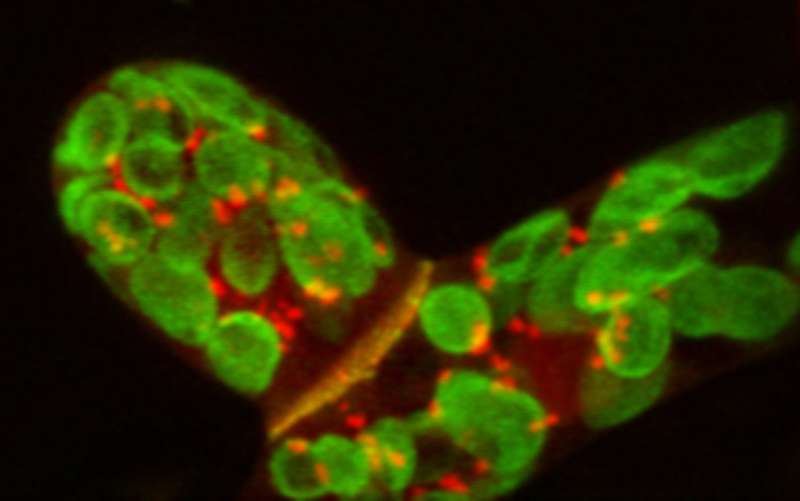This fluorescence microscope image shows moss cell undergoing cell division. Yellow color shows the co-location of For1F and exocytosis machinery while building the new cell wall. Credit: Bezanilla et al. (2018) from the Journal of Cell Biology
Researchers have identified a fused gene in moss that provides insight into how cells build their external walls. The same discovery raises questions about the one-of-a-kind gene that features two distinct proteins that participate in two distinct functions.
The research team identified the novel gene, known as For1F, while studying exocytosis. Exocytosis is the process by which cells secrete packets of protein and carbohydrates outside their membranes to support extracellular processes like the construction of cell walls.
The gene discovered in the research couples the exocytosis-regulating protein Sec10 with formin, a protein that regulates the remodeling of the actin cytoskeleton critical to forming cell shapes.
The new study also shows that the gene fusion occurred early in moss evolution and has been retained for more than 170 million years.
"We were surprised to find this fused gene in the moss genome," said Magdalena Bezanilla, the Ernest Everett Just 1907 Professor of Biology at Dartmouth College. "Through our research, we know that the analysis is correct, now it will be interesting to explore the advantage of this coupling of proteins."
Once For1F was observed, Bezanilla and her team set out to determine how unique this particular conjoined arrangement is. By consulting the database of the 1000 Genomes Project, the researchers found that the fused gene was evident in many diverse species of mosses, but not in other plants.
In all other plant and animal cells, Sec10 and formin are located independently. But, for some reason, the genes are fused in mosses. This unique combination of the genes demonstrates that there is a connection between exocytosis and the remodeling of the cell's internal skeleton, but what that connection is remains unclear.
Further complicating the research, the team also found that the genes did not have to be joined to do their jobs.
According to the paper: "Although not essential, the fusion may have had selective advantages and provides a unique opportunity to probe actin regulation of exocytosis."
"We know that this fusion occurred early in moss evolution and that it has been retained for millions of years," said Bezanilla. "All indications are that there should be some value to this arrangement, but why they are fused in mosses is a mystery."
Bezanilla's research focuses on how single cells and their neighbors work together in moss to construct cell walls over long periods of time. To do so, the team focuses on the molecules that drive the process.
"Moss is the perfect plant to study," said Bezanilla, "it's a great system with cells that are observable under the microscope and with a genome that we can manipulate."
The research appears in the Journal of Cell Biology.
More information: Peter A.C. van Gisbergen et al, An ancient Sec10–formin fusion provides insights into actin-mediated regulation of exocytosis, The Journal of Cell Biology (2018). DOI: 10.1083/jcb.201705084
Journal information: Journal of Cell Biology
Provided by Dartmouth College






















